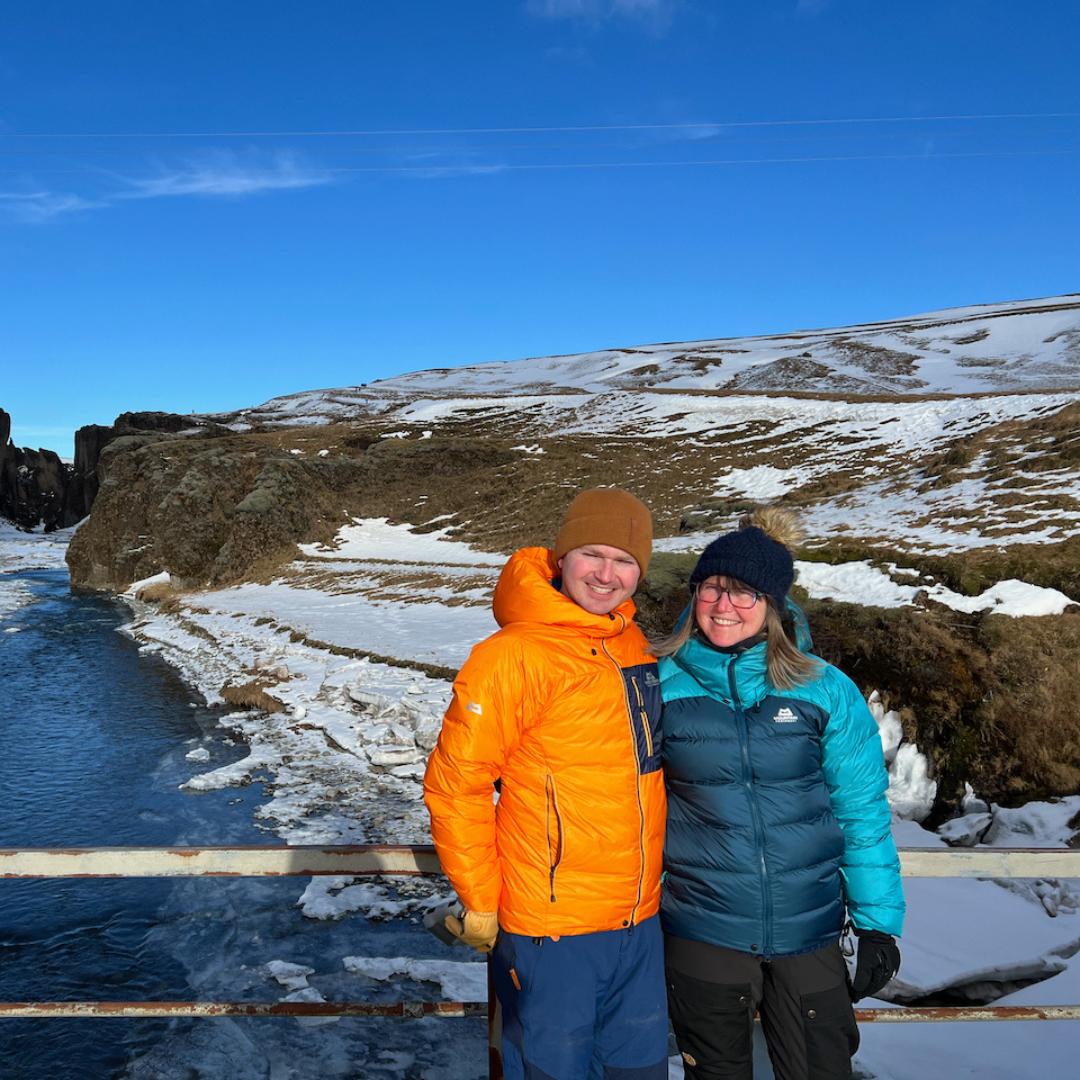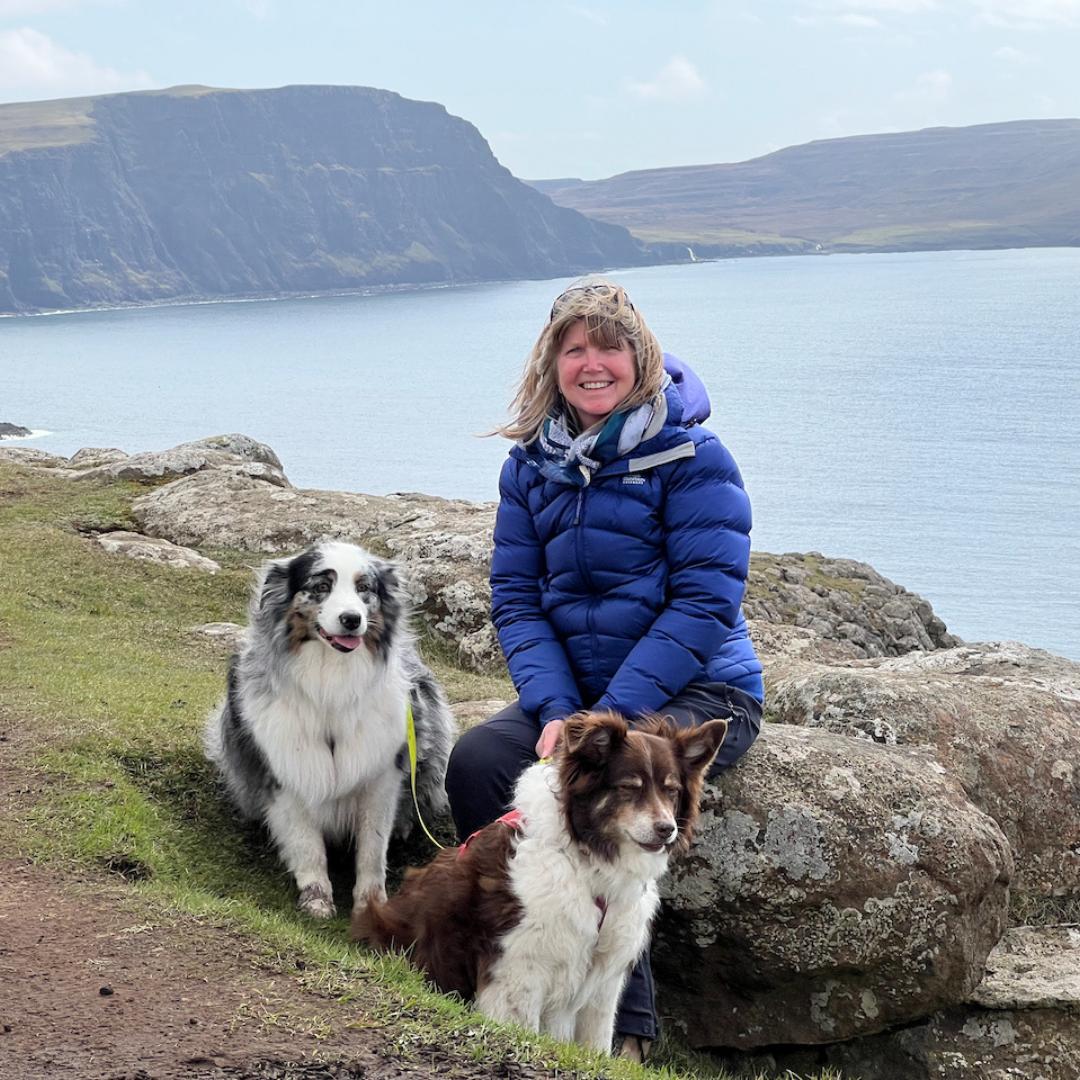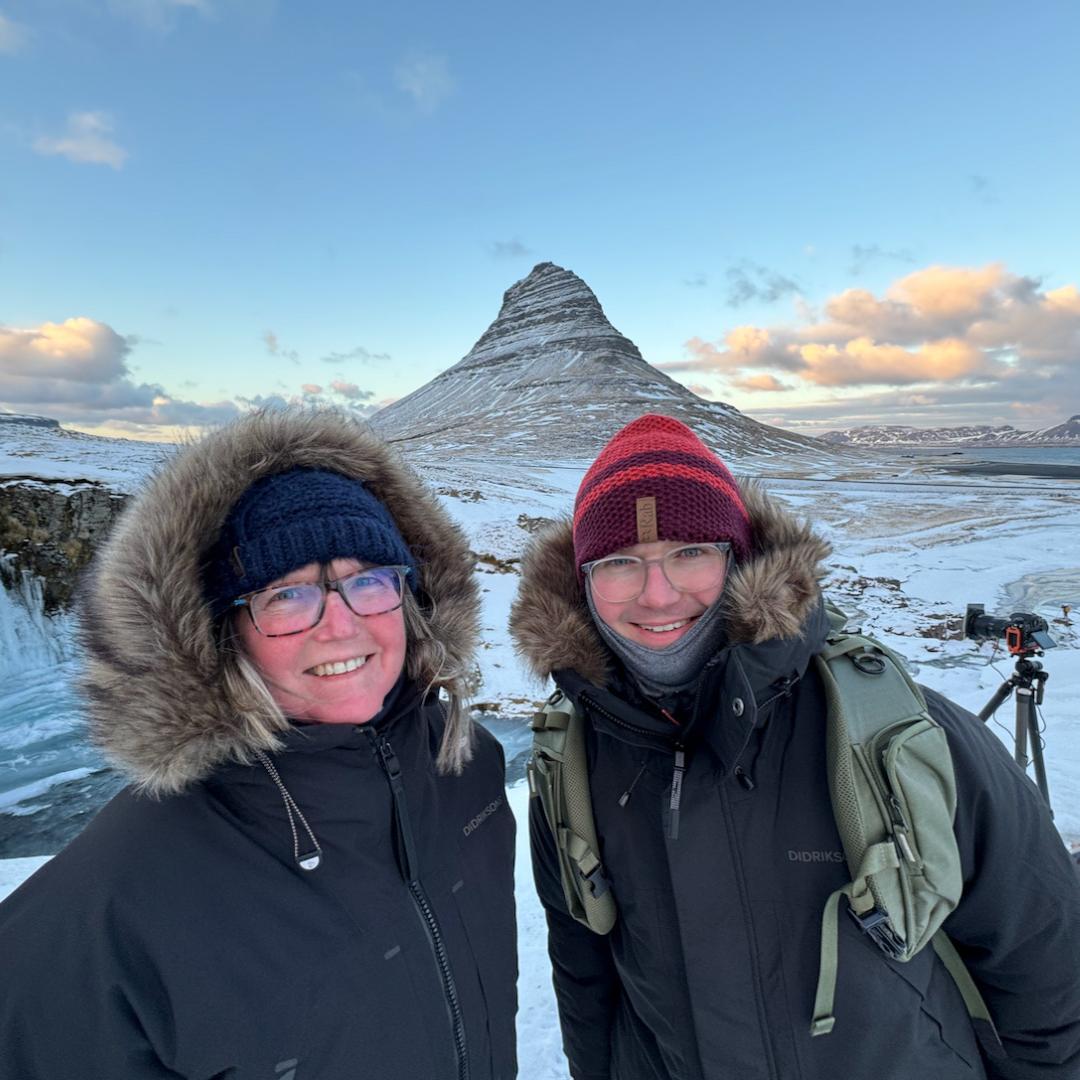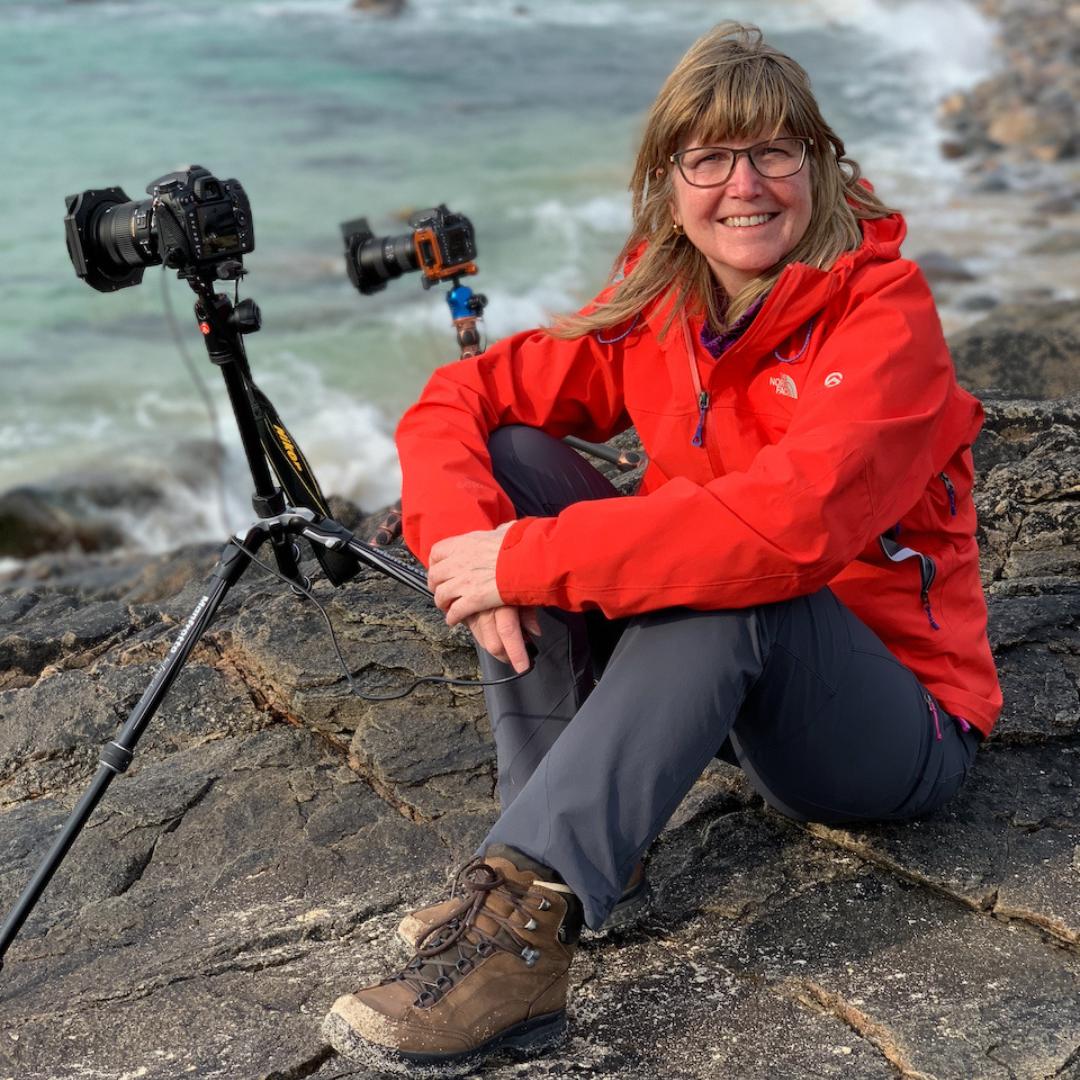Earlier this year, Jane was diagnosed with hypertrophic cardiomyopathy (HCM). Jane has shared her cardiomyopathy journey with us, and how a fundraising photography project has helped her regain confidence.
The diagnosis
A few days before I headed off on a 10-day photographic adventure in Iceland with my eldest son Will, I started to experience shortness of breath when going up the stairs.

Then, on arrival in Iceland, walking from the plane to the arrivals hall, I again experienced shortness of breath, but this was now accompanied with chest pain. Although I suspected that something wasn’t right, at that point, I could quite easily explain it. I had only had a few hours of sleep on the flight, I was wearing a thick parka and carrying several bags of camera, drone, and laptop equipment, and I might not have been as fit as I used to be.
However, on multiple occasions during the trip, I experienced the same symptoms going up hotel stairs – often when not carrying anything. On the last day of our trip, I again experienced shortness of breath and chest pain, but this time I also had pain going down both my arms. Since my father had angina, I thought I may be experiencing it too.
On my return to the UK, I went to see my GP who sent a referral to the rapid cardiac assessment centre, suspecting angina. The following day, while I was working at a GP practice consulting on the General Practice Improvement Programme, I shared how I was feeling with one of the doctors. They recommended I visit A&E. I decided to finish off my work on site and then go home, while considering whether to travel to A&E.
As I sat down at home, I felt more chest pain, shortness of breath and pain going down my left arm – and this time I wasn’t exerting myself. So, following the advice of my GP brother, I called 999. The rapid responder identified a significant inverted T-wave on my ECG (electrocardiogram) and recorded a rapid pulse and raised blood pressure, so they believed I was having a heart attack. I was taken by ambulance to the Royal Victoria Infirmary (RVI) A&E in Newcastle.
Following assessment in A&E they diagnosed me with a heart attack and transferred me to the emergency department. I was monitored throughout the night, with regular blood tests to monitor my raised troponin levels, indicating a heart attack. I was then transferred to the assessment ward and then the coronary care ward later that day.

After an ECG, I was given an initial diagnosis of hypertrophic cardiomyopathy (HCM), with queried hypertrophic obstructive cardiomyopathy (HOCM). The following angiogram showed little atheroma, no coronary heart disease and therefore no stents were required. The consultant stated that I had not had a coronary heart attack. However, the angiogram did identify the thickening of my left ventricle, primarily at the apex. Indeed, on further investigations – including an MRI scan, stress-echocardiogram, and ambulatory ECG – my diagnosis was confirmed as apical hypertrophic cardiomyopathy.
The process through the healthcare system was quite challenging at times, especially the delays. However, by advocating for myself throughout the process, coordinating and helping share information between NHS and private consultants, and talking to administrative staff, I got the scans, tests and appointments that I needed to reach my diagnosis. By being professional, courteous and constructive, people were supportive, which made me feel much better while things were moving along through the system.
Things became complicated when I was moved between hospitals within the hospital trust - from initial admission at the RVI to the Freeman Hospital, to access an angiogram. On my discharge from the Freeman Hospital, I was told I’d be followed up by outpatients for an MRI by my original team at the RVI. This didn’t happen until I politely but persistently followed it up with phone calls, asking questions and being redirected, until I eventually reached the right person to get it sorted.
I continued to advocate for myself and follow up until the MRI was back on track. After the MRI, I arranged an appointment with a private cardiologist and had an initial consultation at the beginning of April - which was a huge relief.
The conversation I had with the cardiologist was very reassuring following his analysis of my case up to that point and an ECG. He amended my hospital discharge drug regime to a more focused HCM regime.
My follow-up appointment with the cardiologist in May was where I got my full diagnosis with my risk score, and an opportunity to ask questions. These questions were all answered to great effect, which was such a relief. I felt like I could start to get my life back on track armed with lots of information from my questions being answered. I certainly felt optimistic as I left the appointment.
Everyone I met or spoke to in the NHS system and the private sector have been extremely helpful and supportive. The NHS appointment I received form the registrar in August to discuss my (April) MRI scan was superb. He was open and honest, answering my questions and addressing my concerns. Because of my degree in physiology and having been raised in a family of doctors and nurses, he was happy to share the MRI report findings in detail, which was reassuring to hear. From apical ventricular thickening, a little valve regurgitation and atrial dilation – this full picture helped me to understand my condition even further. Information is key, in my book, to help patients accept and adapt to their condition – their ‘new normal’.
The doctors, nurses, and admin teams at my surgery have been extremely supportive too, especially as it has been an anxious time, and I have had more contact with them in the last five months than in five years!

Living with cardiomyopathy
I run my own consultancy business, focusing on change leadership and management, which has had to take a back seat while I prioritise my health. I took 6 months off work to build my strength and stamina once more. Having monthly 1-2-1 coaching sessions around my future work ambitions has supported this journey, including exploring what aspects of my business I want to continue with, what elements give me the greatest joy, make me feel happy and where I can reduce unnecessary stress. I have also invested in building my cardio strength with a physiotherapist, go swimming weekly, and go on daily walks – all to boost my fitness as well as mental wellness. This has helped me significantly and I have just returned to work for a few hours a week.
Before my heart issues and diagnosis, I was interacting daily with clients, colleagues and friends. I had a real buzz running my business. I was independent – both physically and financially. I got a huge amount of energy and positivity from these interactions, and the impact that I had on my clients. Then, suddenly, I lost it all overnight. I felt lost, with no one to speak to. I was isolated at home and became very lonely. But once I got that first set of positive news at my April consultation, I could get myself out and about and meet people – even more so following the full diagnosis in May. Life would be what I made of it.

Initially, post-hospital admission and diagnosis, I was proactive, positive, and full of optimism – accepting my new normal and the opportunities that it would offer me. I took control and drove things forward. However, about two months after my hospital admission, I lost my self-confidence, self-belief, and self-esteem. From being full of life, I felt lost. What was my life all about now? My eldest son Will, whom I’d been on my Icelandic adventure with, came to the rescue, suggesting that we raise money for charity through a photographic exhibition and calendar – showcasing our Icelandic photography. We chose Cardiomyopathy UK and British Heart Foundation as they are obviously both close to my heart!
This has given me a new lease of life, a purpose and focus. I feel valued, and it has increased my self-belief and self-confidence. I am so proud of Will for his passion to make this happen and for supporting me on this journey. I am learning so much from him. It has brought me alive once more and allowed me to apply my business skills to our personal project. I also feel proud of myself for committing to this, overcoming my imposter syndrome, and helping to drive it forward for the benefit of others.
Life post-diagnosis has actually helped me to identify many new opportunities to enrich my life and that of others further. For example, I now love volunteering for the Northumberland National Park. Every cloud does indeed have a silver lining.
If you want to get your hands on one of Jane's beautiful 2025 calendars, they are available here.
Watch Cardiomyopathy UK Specialist Nurse Jayne's webinar about empowering yourself to become an expert patient: